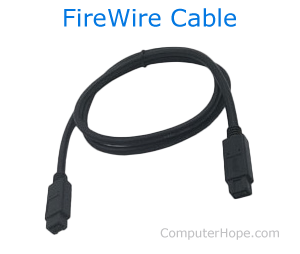FireWire
Updated: 06/07/2019 by Computer Hope

Alternatively called IEEE 1394, FireWire is a digital bus with a bandwidth of 400-800 Mbps and higher. It can handle up to 63 units on the same bus, is hot swappable, and supports PnP (Plug and Play) devices. It was created by Apple in 1995.
Users more familiar with USB (Universal Serial Bus) can consider FireWire similar to USB, as they have some similarities. Like USB, FireWire has several devices, such as removable drives and cameras.
FireWire specifications and versions
- FireWire 400 (IEEE 1394) - The original specification, capable of data transfer speeds of 100, 200, and 400 Mbps; released in 1995.
- IEEE 1394a - An improvement over FireWire 400, adding support for asynchronous streaming, packet concatenation, and a suspend mode for reduced power consumption; released in 2000.
- FireWire 800 (IEEE 1394b) - Increased data transfer rate of up to 3200 Mbps using "beta mode" or using an optical cable; released in 2002.
- FireWire S800T (IEEE 1394c) - Technology improvements to provide 800 Mbps data transfer rate using the same connection as a Cat 5e cable; released in June 2007.
- FireWire S1600 and S3200 - Capable of data transfer speeds of 1.57 Gbps and 3.14 Gbps respectively, and are compatible with FireWire S400 and S800 devices; announced in December 2007.
Tip
Ports labeled as i.Link are Sony's implementation of IEEE 1394.
1394 header, Cable, CamelCase, Connection, Data cable, Hardware terms, IEEE, Motherboard terms, OHCI, Port, USB
